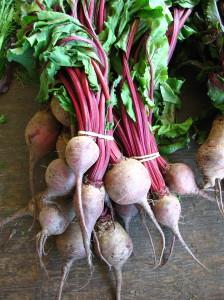Beets
The ancestor of the beet originated in prehistoric times in North Africa and grew wild along the seashores of Asia and Europe. The vegetable was domesticated by 800 BCE, and by the 16th century, large and coarse beet roots were used as livestock feed.
In the beginning of the 19th century, the English blocked the shipment of sugar into Europe during the Napoleonic wars, and thus, out of necessity, the beet sugar industry was born with the first factory built in Poland.
Beets are excellent source of anti-inflammatory compounds, antioxidants, vitamins A and C, and fiber. The greens and stems of the beets can be eaten raw or sautéed (like Spanish or Swiss chard) and are packed with nutrients, vitamins, minerals and carotenoids such as beta-carotene.
The deep red flesh of the root can be steamed, grilled, boiled roasted, roasted or enjoyed raw in a salad. To obtain the best flavor and nutritional content, cook it lightly.
References:
http://lovebeets.com/fastfacts/


